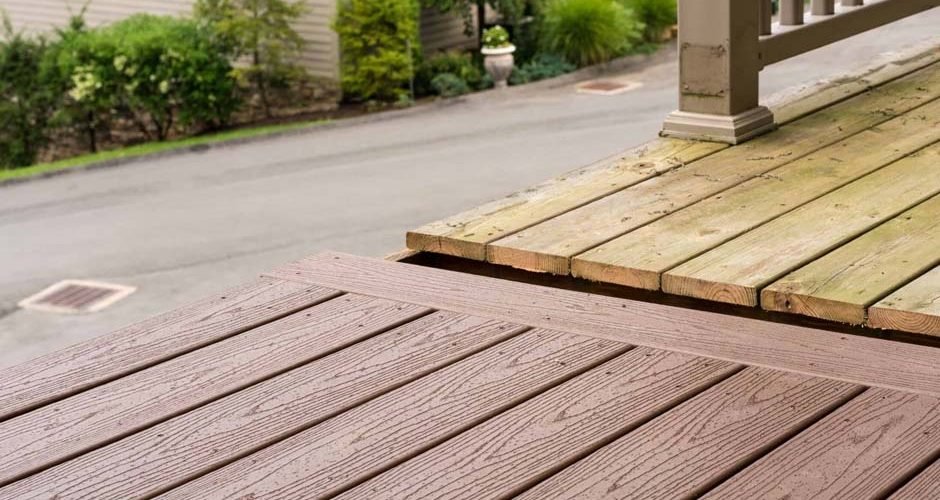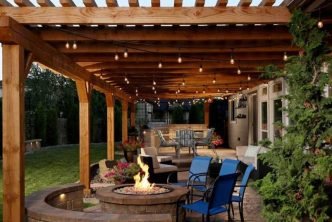Choosing the right decking material is an important decision for any homeowner. After all, your deck is a significant investment, and you want it to last for many years to come. Two of the most popular decking materials available are wood and composite. Each has its own unique advantages and disadvantages, so it’s important to carefully weigh your options before making a decision.
This blog post will compare wood and composite decking in terms of cost, durability, maintenance requirements, environmental impact, design flexibility, and more. We’ll also share some real-life case studies from homeowners who have chosen one material over the other.
Table of Contents
Wood Decking
Pros:
- Natural aesthetic appeal
- Wide variety of wood species to choose from
- Traditional and classic look
- Relatively affordable initial cost
Cons:
- Prone to rot, decay, and insect damage
- Requires regular maintenance, including staining or sealing
- Has a limited lifespan, typically 10-15 years
Best Use Cases:
- Regions with moderate climates
- Homeowners who appreciate the natural look of wood
- Budget-conscious individuals
Composite Decking
Pros:
- Low maintenance requirements and durability
- Resistance to rot, mold, and insects
- Variety of colors and finishes available
- Long lifespan, typically 25-30 years
Cons:
- Higher initial cost than wood decking
- Limited design flexibility compared to wood decking
- Environmental considerations (some composite decking materials are not recyclable)
Best Use Cases:
- High-traffic areas and families with kids/pets
- Homeowners looking for a long-term, low-maintenance solution
- Those interested in eco-friendly materials
Cost Comparison
- Initial cost: Composite decking is typically more expensive than wood decking upfront. However, it’s important to consider the long-term cost of ownership, which takes into account maintenance and repairs. Over time, composite decking can be more cost-effective than wood decking, especially in high-traffic areas or regions with severe weather conditions.
- Long-term cost: Wood decking requires regular maintenance, such as staining or sealing, to prolong its lifespan. Composite decking, on the other hand, requires very little maintenance. This can save you money in the long run.
- Return on investment (ROI): The ROI for wood and composite decking will vary depending on a number of factors, such as the climate, the type of wood or composite material used, and the overall quality of the installation. However, in general, composite decking is considered to have a higher ROI than wood decking, especially in high-traffic areas or regions with severe weather conditions.
Environmental Impact
- Wood sourcing: Wood decking is made from a natural resource, but it’s important to choose wood that is sourced from sustainable forests.
- Eco-friendliness of composite materials: Composite decking is made from a variety of materials, including recycled plastic and wood fibers. Some composite decking materials are more eco-friendly than others. For example, Trex decking is made from 95% recycled materials.
- Responsible disposal and recycling: It’s important to dispose of and recycle wood and composite decking responsibly. Wood decking can be composted or recycled, while composite decking can be recycled through some programs.
Design and Customization
- Wood decking: Wood decking offers a lot of design flexibility. Homeowners can choose from a variety of wood species, colors, and finishes to create a unique look.
- Composite decking: Composite decking also offers a variety of colors and finishes. However, it’s important to note that composite decking does not have the same natural look as wood decking.
Maintenance and Care
- Wood decking: Wood decking requires regular maintenance to prolong its lifespan. This includes cleaning, staining, or sealing the wood every year or two.
- Composite decking: Composite decking requires very little maintenance. Homeowners simply need to clean the deck with soap and water on a regular basis.
Choosing the Right Material for Your Needs
When choosing between wood and composite decking, it’s important to consider your specific needs and preferences. Factors to consider include:
- Climate and local conditions: If you live in a region with severe weather conditions, such as high humidity or extreme temperatures, composite decking may be a better choice than wood decking.
- Budget and long-term goals: Composite decking is more expensive upfront than wood decking. However, it can be more cost-effective in the long run, especially in high-traffic areas or regions with severe weather conditions.
- Aesthetic and design preferences: If you prefer the natural look of wood, then wood decking is the right choice for you. However, if you’re looking for a low-maintenance decking material with a variety of color and finish options, then composite decking is a good choice.
Conclusion
So, which decking material is right for you? It depends on your specific needs and preferences. If you’re looking for a natural-looking, affordable decking material, then wood decking is a good choice. However, if you’re looking for a low-maintenance, durable decking material that is resistant to rot, mold, and insects, then composite decking is a good choice.
Here is a final recommendation based on the factors discussed:
If you live in a region with moderate weather conditions and appreciate the natural look of wood, then wood decking is a good choice.
If you live in a region with severe weather conditions or are looking for a low-maintenance, durable decking material, then composite decking is a good choice.





